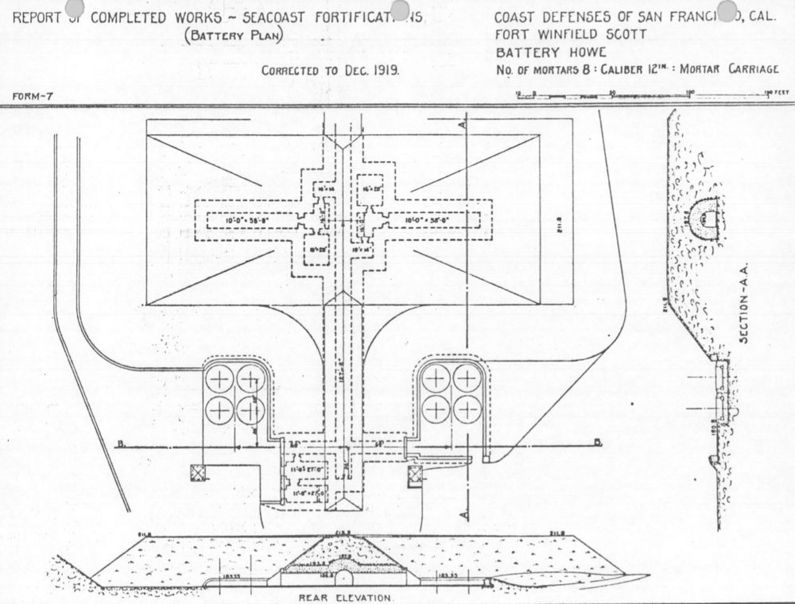Battery Howe (1)
|
Battery Howe (1) (1893-1920) - Battery Howe is a concrete Endicott Period 12" mortar battery located on Fort Winfield Scott (2), San Francisco County, California. Named 14 Feb 1902, General Order 16, after Col. Albion P. Howe (Cullum 1066), 4th U.S. Artillery, who served in the Mexican-American War and the U.S. Civil War. The Battery was begun 5 Apr 1893, completed in June 1895 and transferred to the Coast Artillery for use 1 Jun 1900 at a total cost of $144,247.15. All mortars and carriages were ordered scrapped 26 May 1920.
Endicott Period (1890-1910)Part of the Harbor Defense of San Francisco.  Originally built between 1893 and 1895 with sixteen 12" M1886 and M1886M rifled mortars on M1891 mortar carriages in a concrete battery with four mortar pits (A-D). It was originally known as Fort Point (3) Battery No. 1 and was accepted for use 1 Jun 1900 and named for Col. Howe on 14 Feb 1902. In 1906, General Order 20 renamed mortar pits C and D as Battery Wagner (1) and pits A and B retained the Battery Howe name. Battery Howe was originally built with the two sets of mortar pits separated by a large central earth covered magazine complex. It appears to be the only 12" mortar battery built in this configuration.

World War I (1917-1918)On 27 Oct 1915, Battery Howe was declared "of insufficient military value to warrant provision of manning personnel and ammunition therefore" but it seems to have emerged from World War I with all its armament in place. Engineering memorandum dated 21 Feb 1918 indicates that, after all the removals for World War I overseas service, Battery Howe still had its eight 12" mortars. It does appear that none of the 12" M1886 cast iron, steel hooped mortars were sent overseas indicating that they were not suitable for rail mounting. Battery Howe also escaped the earlier program to remove two mortars from each pit to give the crews more room to operate. Post World War IOn 30 Sep 1919 the U.S. Secretary of War ordered 72 of the existing 82, M1886 and M1886M mortars and their carriages scrapped. The Battery Howe RCW dated 1 Mar 1920 shows all eight mortars still mounted. The Ordnance Department followed with instructions for the scrapping on 26 May 1920 and that is the scrapping date on the gun and carriage cards for Battery Howe. This same scrapping date is found on many gun cards of varying calibers so it was clearly part of an overall disarmament program. Current StatusPart of the Golden Gate Recreation Area (GGNRA) administered by the National Park Service. No guns or carriages are in place. Only mortar pit A is visible today with its booth, the other three pits are buried.
Sources:
Links: Visited: 22 Aug 2009 | ||||||||||||||||||||||||||||||||||||||||||||||||||||||||||||||||||||||||||||||||||||||||||||||||||||||||||||||||||||||||||||||||||||||||||||||||||||||||||||||||||||||||||||||||||||||||||||
- Harbor Defense of San Francisco
- 12" Mortar M1886M
- 12" Mortar Battery
- 12" Mortar M1886
- Visited
- All
- California All
- California Battery
- Battery Howe (1)
- California San Francisco County
- National Historic Site
- Preserved
- Endicott Period Battery
- Coastal Battery
- Fort Winfield Scott (2)
- 1920 Disarmament Program
- 2009 Northern California Trip


